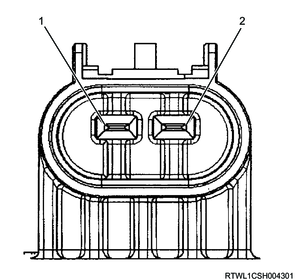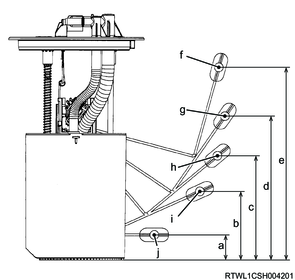1. Fuel tank unit inspection
1. Airtight inspection
Caution
- After installing the fuel tank unit to the fuel tank, perform the airtight inspection.
1) Connect the fuel filler hose to the filler neck and fuel tank.
2) Connect the breather hose to the filler neck and fuel tank.
3) Plug the return pipe connection outlet of the fuel tank unit.
4) Install the fuel filler cap to the filler neck.
Caution
- Tighten until it makes a clicking sound at least once.
5) Apply soapy water to the area around the fuel tank unit seal.
6) Apply air from the feed port of the fuel tank unit to the fuel tank for 15 seconds or more to the specified pressure.
34.3 kPa { 0.3 kgf/cm2 / 5 psi } Specified pressure
7) Verify that bubbles are not coming out around the fuel tank unit seal.
2. Resistance measurement
The fuel tank unit changes the internal resistance in accordance with the float position, which varies depending on the fluid surface height, and operates the fuel meter indicator.
1) Move the float to each position and measure the resistance between the connector terminals using a DMM.

Legend
- Positive side power supply terminal
- Ground terminal

Legend
a. Distance from bottom to E stopper
b. Distance from bottom to 1/4 position
c. Distance from bottom to 1/2 position
d. Distance from bottom to 3/4 position
e. Distance from bottom to F stopper
f. F stopper
g. 3/4 position
h. 1/2 position
i. 1/4 position
j. E stopper
| Float position |
Distance |
Net volume |
Resistance |
| F stopper |
221.5 mm { 8.720 in } |
73.5 L { 19.42 US gal / 16.17 Imp.gal } |
14 to 20 Ω |
| 3/4 position |
165.5 mm { 6.516 in } |
55.2 L { 14.58 US gal / 12.14 Imp.gal } |
31.25 to 37.25 Ω |
| 1/2 position |
120.0 mm { 4.724 in } |
39.9 L { 10.54 US gal / 8.78 Imp.gal } |
42 to 48 Ω |
| 1/4 position |
79.0 mm { 3.110 in } |
24.7 L { 6.52 US gal / 5.43 Imp.gal } |
69.75 to 77.75 Ω |
| E stopper |
29.0 mm { 1.142 in } |
6.5 L { 1.72 US gal / 1.43 Imp.gal } |
140 Ω or more |
2) Connect the connector on the vehicle to the fuel tank unit and move the float.
3) Verify that the low fuel warning light illuminates under the following float conditions.
| Float height |
Net volume |
Resistance |
| 47.5 mm { 1.870 in } |
12.5 L { 3.30 US gal / 2.75 Imp.gal } |
96.35 to 98.40 Ω |
Note
- Replace the fuel tank unit if a malfunction is found.